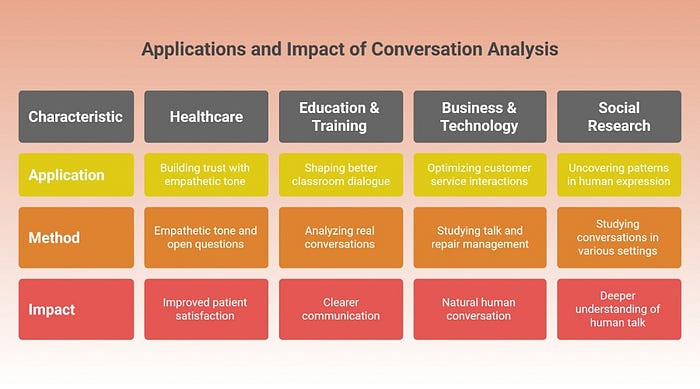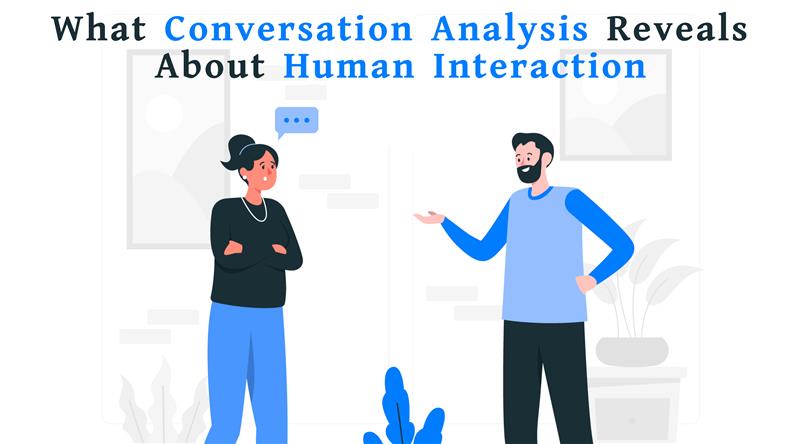Have you noticed the hidden rules in everyday speech? Conversation Analysis uncovers hidden structures within interactions. CA studies our word by word and pause-by-pause communication. It makes exquisite records of actual conversations (from family discussions to doctor visits), not instructions to people on what to say.
The fascinating finding: casual conversations are essentially organized. CA prescribes how people negotiate meaning, coordinate turn-taking, express emotion, or express power in talk. In my interactions, my friend instinctively replies, “Coffee or tea?”, called by CA a question-answer adjacency pair.
What Is Conversation Analysis?
Harvey Sacks, Emanuel Schegloff, and Gail Jefferson pioneered Conversation Analysis in the 1960s. It was discovered that everyday talk is shaped by subtle cues and hidden rules. Teams in California record and transcribe conversations ranging from meetings to family dinners. Our unconscious “tacit rules” must be brought into awareness. Therefore, CA views conversation as a social window.
Communicators build relationships by mapping talk and the patterns of turn-taking and responses. It includes more than just words: conversational gestures, glances, silences, and intonations are all part of CA transcripts. For example, they might note a short pause or a nod, since a look or gesture can change the meaning of a statement.
“The organization of talk-in-interaction is foundational for human understanding” — Schegloff (2007)
Hidden Patterns of Talk: Turns, Pairs and Repairs
Conversation Analysis shows that everyday conversation follows rules, just like the unwritten rules of friendly sports games. Everyone takes part, even if you don’t see it. What is the foundation? Taking turns, pairs of things next to each other, and fixing:
- Turn-taking: People take turns speaking, with a pause, eye contact, and intonation setting the frame for the next speaker. This system follows some well-predicted rules. I tell a story and very gently lower my voice, and you respond. CA studies this alternation.
- Adjacency pairs: Certain phrases only allow for specific responses. Greeting/greeting, question/answer, offer/accept, apology/accusation. If a person says, “Hi, how are you?” he will usually get a response such as “I’m fine, thank you.” This is the classic adjacent pair of turns. CA famously found that the first part of such pairs sets an expectation for the second. And thus, if speakers do not receive what they expect as an answer, they either correct or probe.
“The first pair part constrains the next… it sets up an expectation” — Heritage (1984)
- Repair mechanisms: Misunderstandings are part of talk, but we handle them smoothly. CA shows how we “fix” errors using repair strategies — like saying “Sorry?” or “I mean…” These small corrections follow patterned rules, not randomness. Whether reformulating a thought or prompting clarification, such repairs help keep conversations flowing without conflict.
So, these structures demonstrate that small talk doesn’t just fall apart-they are a tight dance of cues, responses, corrections. I observed it: during a friendly debate, I paused to think for a moment; my friend immediately jumped in to take her turn. That rhythm? Pure CA.
More Than Words: Nonverbal Cues and Context
Conversation Analysis goes beyond words. It includes nodding, smiling, eye contacting, glancing and silencing within dialogue. One CA gem says doctors comfortingly talk or look at the patient for reassurance: sometimes it is the tone, sometimes the look, sometimes the words.
In my experience, even a grunt or “hmm” in a friendly way to listen encourages the speaker-a back-channel cue, according to CA. A CA transcription system like Jefferson-phonetically rich in information-would stage all word lengths and overlaps as data. Context shapes it all. For CA, location and who speaks matter. Your manner of conversing changes between a coffee shop and a formal meeting. One culture considers eye contact polite, while the other finds it aggressive.
Higher-status speakers take longer turns or interrupt, while other speakers do so quietly or hesitantly. I recall one group discussion where the manager rarely paused, whereas the lower-level staff waited for their turns. CA could show explicitly how these subtle conversational moves index social roles.
Real World Insights and Impact
Conversation Analysis has far-reaching applications beyond academic study, offering real improvements in everyday communication:
- Healthcare: CA helps doctors build trust by using empathetic tone and open-ended questions. These subtle shifts like saying “Tell me more” instead of closed queries have been shown to improve patient satisfaction and health outcomes.
- Education & Training: Teachers use CA to shape better classroom dialogue, while coaches apply it in training professionals. Analyzing real conversations helps identify moments of interruption or silence that could be improved for clearer communication.
- Business & Technology: Companies optimize customer service by studying how agents manage talk and repairs. Even AI assistants are being trained on CA principles to mimic natural human conversation and handle misunderstandings politely.

Conclusion
Thanks to CA, we’re more aware of why we communicate the way we do. CA gives concrete terms such as “repair” and “adjacency pair” to analyze talk. Awareness enhances daily interactions. Treat turn-taking as a way to improve your listening by also spotting the speaker reference for someone they’re waiting to speak.
Instead of getting frustrated with repair that led to rephrasing, consciousness of these patterns makes the conversation smoother after a pause or downward inflection. In short, conversation analysis shows that even our casual chats are guided by hidden logic. Study those patterns of talk, what they show is how we construct meaning, maintain relations, and manage talk about social norms.
It is a reminder that every time anyone says “Hello,” or asks a question, they are following a social choreography that CA has helped uncover.
“We live in a world accomplished through conversation.” — Garfinkel
FAQ’s
1. How does CA help in real life?
It enhances communication, business, technical design and healthcare. It shows successful or unsuccessful communication.
2. What are adjacency pairs?
The structure of conversation in CA involves a daily routine to adhere to a fixed schema from question/answer to greeting/greeting.
3. Is CA only about spoken words?
Nope! It also uses non verbal communication.
4. Can anyone use CA?
Yes. In every field, you can observe and apply its insights to become a better communicator.
References
Sacks, H., Schegloff, E. A., & Jefferson, G. (1974). A simplest systematics for the organization of turn-taking for conversation. language, 50(4), 696–735.
Heritage, J. (1987). Ethnomethodology. Social theory today, 224–272.
Garfinkel, H. (2023). Studies in ethnomethodology. In Social Theory Re-Wired (pp. 58–66). Routledge.





Comments